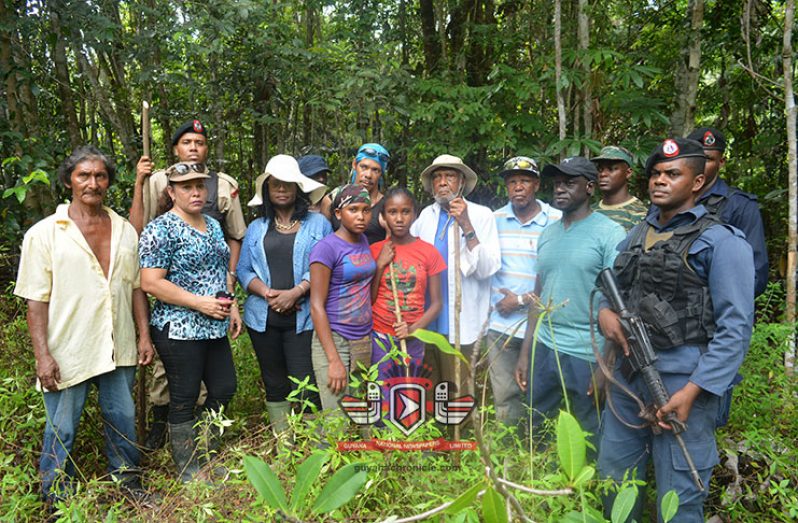Story and Photos by Svetlana Marshall
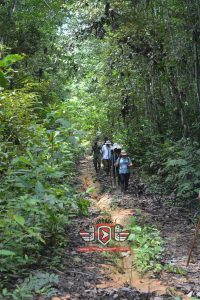
AS the tears trickled down her cheeks, Onica Butts just sat there silently in the grass, a stone’s throw from where the bodies of her reputed husband and seven other miners were haphazardly placed on top of each other and set afire after being shot and killed by armed gunmen at a camp in Lindo Creek in the Upper Berbice River in Region 10.
Remnants of a blue tarpaulin and an enamel cup that had seen better days were visible in the sand where it is said that the charred remains of the miners were found on Saturday June 21, 2008 by owner of the mining camp, Mr Leonard Arokium. A rusted ‘lavadora’, the machine used by the miners to wash the gravel to get to the diamonds, an engine and several dented and corroded drums, along with a black rubber tube could be seen at different ppoints of the camp now partially covered with vegetation.
Butts was among the first to arrive on Friday at the scene of the June 2008 massacre, ahead of a 23-member team led by Chairman of the Lindo Creek Commission of Inquiry (COI), Justice (Retired) Donald Trotman.
In fact, Butts and Mr Edmond Torres and his three children (Talia, Tanasha and Xaviar, ages 14, 17 and 18) created history by becoming the first family to ever set foot on the scene of the gruesome crime within the past decade. Mr Torres is the father of 17-year-old Nigel Torres, one of the eight Lindo Creek victims.
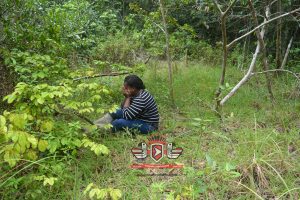
As Butts sat quietly contemplating perhaps what life would have been like had the father of her two children, Dax Arokium, been alive, Justice Trotman upon arrival at the campsite, gathered the members of his team and observed a moment of silence.
Among those in his entourage were the Commission’s Legal Counsel Patrice Henry, and its Public Relations Officer, Melanie Morris; Guyana Defence Force (GDF) Officer, Sherlock Rigby; four ranks of the Guyana Police Force, namely Corporals Gasper and Bruce, and Constables Akeem Bacchus and Shain Kippins; and two tour guides, Carl Jacobs and Kevin Campbell.
In his quest to find the truth about what transpired the day the eight miners were murdered, Justice Trotman proved naysayers wrong when he and his team travelled the more than 119 miles from Kwakwani, through the treacherous UNAMCO Trail for a period of two-and-a-half hours, using 4×4 vehicles before it was time to come off the road.
At that point, the team then trekked through the forest, covering rough terrain in the process. The fallen trees, the steep and slippery hills, and the five creeks proved to be the most difficult to manoeuver during the more than two-hour-long journey to the scene of the massacre.
Public Health Ministry’s Medex Lolitta Rebeiro and Justice Trotman’s Security Carl McLeod were also part of the team, along with five media operatives.
TOUGH GOING
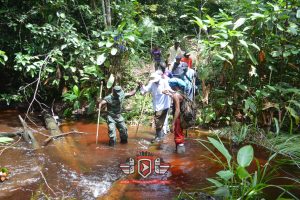
Though describing the journey to Lindo Creek as “rough, hazardous and strenuous”, Justice Trotman was determined to reach the camp, and he did with the assistance of Officer Rigby, the police and the tour guides.
After observing the minute of silence, Justice Trotman told those gathered that the journey was critical to the inquiry, while declaring that history was being created by the team.
“We cannot dwell upon the atrocities and the sorrows,” he began. “We have to dwell on the hopes and the future, so that our being here today could very well mean that no similar atrocities in the future will be committed by anyone else in our nation.
“And we hope also that our presence here will encourage the appropriate authorities of our State and Government to afford and accord the responsibilities which they have to protect their citizens in times of peace and in time of peril. So as we leave here today, history will remember that we met here in a spirit of inquiry; in a spirit of wanting to find the truth of what happened so that something similar will never happen again in our country among our people.”
Standing at a vantage point on the campsite, Mr Torres stood by himself observing the area while his three children combed it. “I feel very sad,” he told the Guyana Chronicle as the tears welled in his eyes. His son had gone to Lindo Creek in search of work when he met his demise.
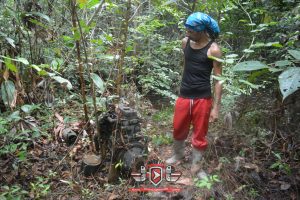
According to Mr Torres, he almost broke down in tears at sight of Butts crying silently in the grass, but though it took some doing, decided to hold it in.
“But I glad to see where my son died and burn,” he said, adding that he’d heard of the area where the tragedy occurred, but it was the first time in 10 years that he was given the opportunity to visit the scene.
For him and his three remaining children, it was important to be there. His wife, Yonette, could not bear stand in the area where her son was shot, killed and burnt, so she remained at home at the Kwakwani Waterfront.
CONFLICTING THEORIES
Based on the journey he’d undertaken that day, Mr Torres concluded that it was impossible for the Rondell ‘Fine-Man’ Rawlins’ gang to commit the gruesome crime while on the run from the Joint Services. “Never! Never! It is not the “Fine-Man Gang”! Not them!” he told this newspaper.
The theory is that after the gang came under police fire at Christmas Falls, further up the Berbice River, on June 6, 2008, they crossed the river and, coming upon the miners at Lindo Creek, they executed them.
However, based on the geographical location, persons familiar with the terrain are maintaining that it was impossible for the gang to reach Lindo Creek from Christmas Falls while being on the run from the Joint Services.
Kevin Campbell, an ex-policeman-turned miner who is familiar with area in the Upper Berbice River, expressed similar views while speaking to the Guyana Chronicle and Newsroom.
“It is highly impossible!” he said. “They can’t meet here! Let me tell you from my heart, is not they do it! I ain’t buying that! And no li’l child wouldn’t buy that either; is not they do it!” Campbell maintained.
Campbell, during his annual leave while in the Force, had worked with the miners. He left the Force the same day he heard of the gruesome killing and one year after when he returned to the scene, he found skeletal remains.
“It was sad to know they said that they picked up all the bones them, and when you come again, bones still remaining,” Campbell said. Upon finding the bones of the miners, Campbell said he put them in a black plastic bag and buried them in the sand a short distance away from where they were burnt.
CALL FOR JUSTICE
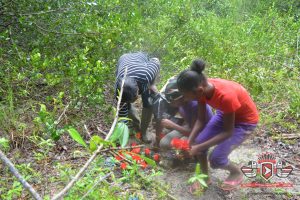
Today, he, like the Torres family, is calling for justice to prevail. “I hope for my sister to get justice for her husband; I would glad for her to get justice, and I need justice for my friends them too,” Campbell said.
Though Butts was too distraught to speak on the scene, she subsequently opened up to this newspaper. “The journey that I took yesterday was challenging,” she said. “And from what they’re saying that it’s ‘Fine-Man’, it’s highly impossible for a man on the run to commit such a crime, knowing that people are after him.”
Four months pregnant with her second child at the time, Butts said she was in a state of shock and disbelief upon learning that her reputed husband had been murdered. Today, close to 10 years later, facing reality is still major struggle for her.
Before leaving the mining camp on Friday afternoon, Butts, along with the members of the Torres family, paid homage to their loved ones by laying flowers at the spot where their burnt remains were found.
Cecil Arokium, Horace Drakes, Bonny Harry, Lancelot Lee, Compton Speirs and Clifton Berry Wong were the other miners that were murdered.



.jpg)



